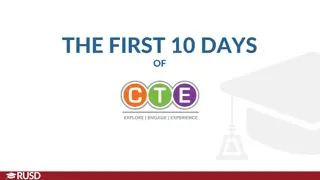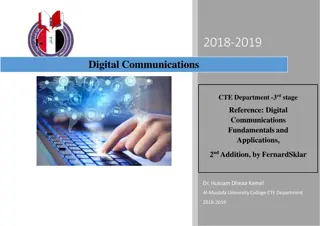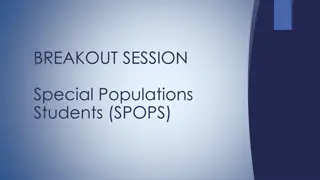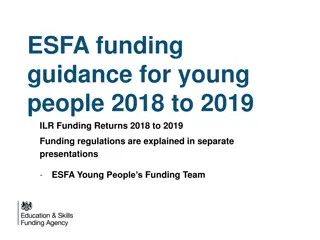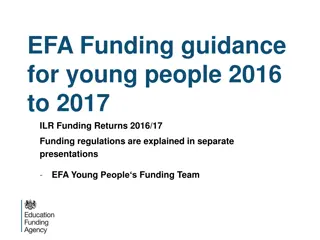
Career & Technical Education Centers in New Hampshire
Explore the funding mechanisms and programs associated with Career & Technical Education Centers in New Hampshire, including Perkins Funding, tuition, transportation, and regional allocations. Discover the vital role these centers play in supporting both state and local employment needs.
Uploaded on | 0 Views
Download Presentation

Please find below an Image/Link to download the presentation.
The content on the website is provided AS IS for your information and personal use only. It may not be sold, licensed, or shared on other websites without obtaining consent from the author. If you encounter any issues during the download, it is possible that the publisher has removed the file from their server.
You are allowed to download the files provided on this website for personal or commercial use, subject to the condition that they are used lawfully. All files are the property of their respective owners.
The content on the website is provided AS IS for your information and personal use only. It may not be sold, licensed, or shared on other websites without obtaining consent from the author.
E N D
Presentation Transcript
Presentation to the Commission to Study School Funding June 5, 2020
What are Career & Technical Education Centers? There are 20 CTE Regions within New Hampshire allowing students the ability to attend one of 26 CTE centers within the state, and 5 CTE centers along border towns in Vermont. RSA188-E:1 Programs at each center vary by location, designed to support both state and local employment needs.
What is Perkins Funding? The Strengthening Career and Technical Education for the 21st Century Act (Perkins V) is a Federal formula grant program which provides funding to each state to enhance career and technical education programs. The annual amount is calculated through a formula identified in the legislation, which takes into account the state s previous base allocation as well as per capita income. New Hampshire s most recent allocation is $6,148,797.00
Perkins Funding, cont. 85% of the state allocation is to be distributed to the Regional CTE Centers and post-secondary institutions. NH divides this at a ratio of 80/20. The regional center allocation is calculated using a formula that takes into account not only the number of students residing in the region, but also the number of students living below the poverty line. Regional centers submit an annual request for funds which outlines how they intend to utilize their allocation.
How else are Career & Technical Education Centers Funded? NH CTE Centers are built and renovated by a combination of state and local funds, and are owned and managed by the school district in which they reside. RSA 188-E:3, RSA 188-E:10 Annual operating funds for each center are the responsibility of the host district. Each CTE center receives an annual allocation of Perkins funds from the state grant. Centers are also eligible for innovation and competitive grants from the state Perkins allocation.
What is Tuition & Transportation? The Department of Education budget includes an allocation for Tuition and Transportation currently $9M per year. This amount is to be used to reimburse sending school districts for transportation expenses and pay a portion of the tuition expense. RSA 188-E:6, E:7, E:8, E:9 There is a formula for each category of payment, with transportation being paid first, and then tuition paid from the remaining balance.
Transportation Reimbursement Sending districts are reimbursed at a rate of 10 cents per mile per student transported on a bus. Students who self-transport are eligible for reimbursement at a rate of 25 cents per mile. School districts submit a form in February and again in June reporting on the number of students transported each day for the previous semester. The total reimbursement is calculated and paid to the districts by December 1.
Transportation Reimbursement, cont. In the example provided (FY19), sending schools expended a total of $2,606,859.51 to transport students to regional CTE centers, and were reimbursed $673,398.19; a shortfall of $1,933,461.32
Tuition Payment Each year the districts calculate the total cost per student. From this figure, the CTE tuition is calculated by utilizing a factor of 20-40% of the total cost. Sending districts are responsible for 25% of the CTE tuition RSA 188-E:6 The balance of the state appropriation (after transportation is paid) is then divided by the total number of CTE students to determine the per student reimbursement amount.
Tuition Payment, cont. If this amount is below 75% of the CTE Center tuition, the sending districts will provide the difference. In the example provided (FY20), the per student reimbursement rate was $3,800.06 75% of total calculated tuition was $10,383,304.01; CTE centers were paid $8,112,485.36; a shortfall of $2,270,818.65 Note that the $3,800.06 reimbursement was actually higher than the 75% tuition at 9 centers, resulting in a net gain; while substantially lower at others.
What Do Others Do? In Massachusetts CTE programs are defined and approved under Chapter 74. Students who attend Chapter 74 approved programs are entitled to an adequacy-like adjustment of $5,120. Delaware utilizes a multi-step approach to calculating the base allocation for all education programs. In addition, the CTE office oversees 5 regional CTE high schools as well as CTE programs located at comprehensive high schools. The office manages a budget of $89M to fund the operation of the schools plus 75% of the CTE teacher salaries.
Delaware Comparison New Hampshire Delaware Total Population Median age 1,363,852 975,033 39.8 42.7 High school population Number of School Districts Number of High Schools High Schools with CTE programs % of HS with CTE CTE student population % of HS students in CTE 64,000 103+ 44,000 19 45 43 82 28 34% 9,000 14% 96% 26,000 59% Perkins funding State CTE Funding $6.1M $9M $5.5M $89M




